Hoffman D.M., Singh B., Thomas J.H. (Eds). Handbook of Vacuum Science and Technology
Подождите немного. Документ загружается.

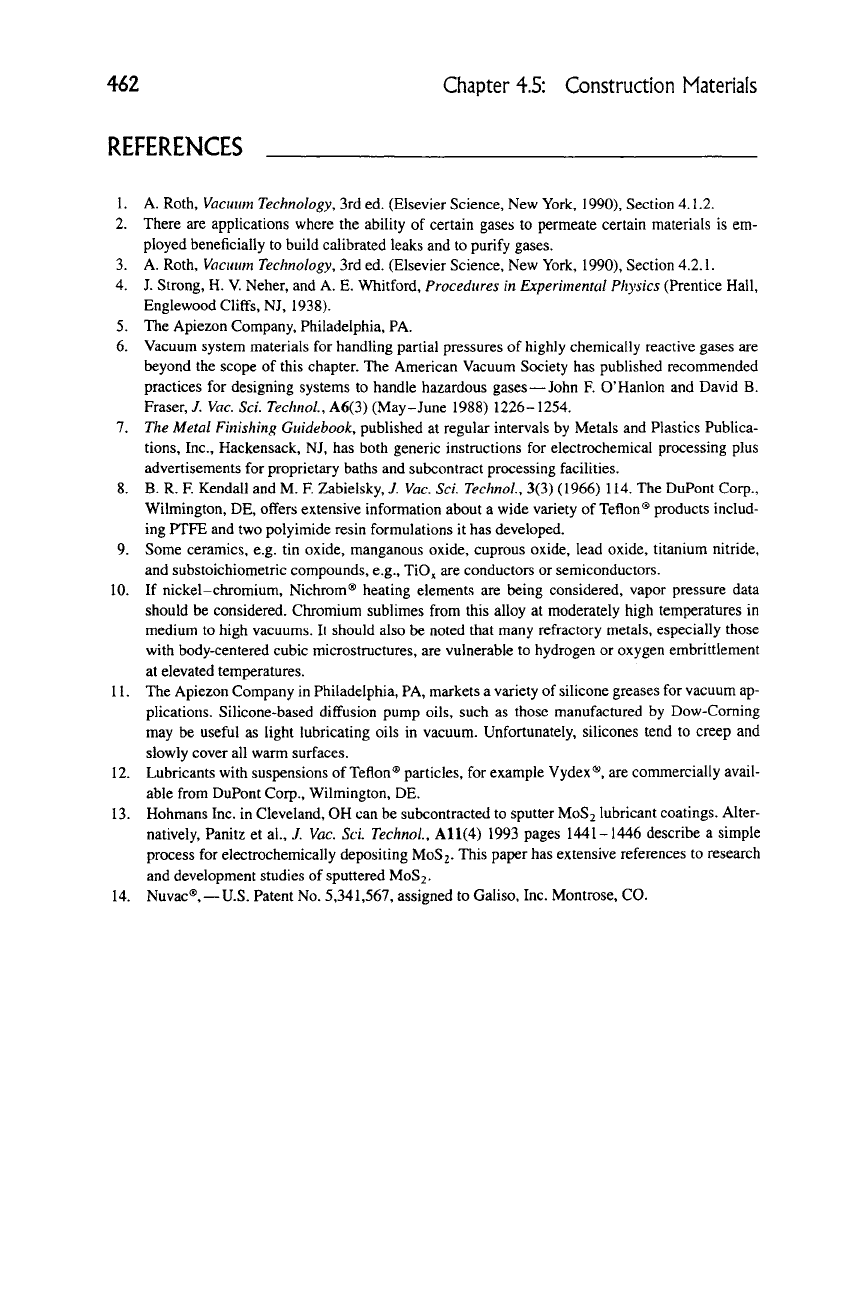
462 Chapter 4.5: Construction Materials
REFERENCES
1.
A. Roth,
Vacuum
Technology,
3rd ed. (Elsevier Science, New York, 1990), Section 4.1.2.
2.
There are applications where the ability of certain gases to permeate certain materials is em-
ployed beneficially to build calibrated leaks and to purify gases.
3.
A. Roth,
Vacuum
Technology,
3rd ed. (Elsevier Science, New York, 1990), Section 4.2.1.
4.
J. Strong, H. V. Neher, and A. E. Whitford, Procedures in
Experimental
Physics (Prentice Hall,
Englewood Cliffs, NJ, 1938).
5. The Apiezon Company, Philadelphia, PA.
6. Vacuum system materials for handling partial pressures of highly chemically reactive gases are
beyond the scope of this chapter. The American Vacuum Society has published recommended
practices for designing systems to handle hazardous gases—John F. O'Hanlon and David B.
Eraser,/
Vac.
Set.
TechnoL,
A6(3) (May-June 1988) 1226-1254.
7.
The
Metal
Finishing
Guidebook, published at regular intervals by Metals and Plastics Publica-
tions,
Inc., Hackensack, NJ, has both generic instructions for electrochemical processing plus
advertisements for proprietary baths and subcontract processing facilities.
8. B. R. R Kendall and M. E Zabielsky,
J. Vac.
Sci.
TechnoL,
3(3) (1966) 114. The DuPont Corp.,
Wilmington, DE, offers extensive information about a wide variety of Teflon® products includ-
ing FIFE and two polyimide resin formulations it has developed.
9. Some ceramics, e.g. tin oxide, manganous oxide, cuprous oxide, lead oxide, titanium nitride,
and substoichiometric compounds, e.g.,
TiO^
are conductors or semiconductors.
10.
If nickel-chromium, Nichrom® heating elements are being considered, vapor pressure data
should be considered. Chromium sublimes from this alloy at moderately high temperatures in
medium to high vacuums. It should also be noted that many refractory metals, especially those
with body-centered cubic microstructures, are vulnerable to hydrogen or oxygen embrittlement
at elevated temperatures.
11.
The Apiezon Company in Philadelphia, PA, markets a variety of silicone greases for vacuum ap-
plications. Silicone-based diffusion pump oils, such as those manufactured by Dow-Coming
may be useful as light lubricating oils in vacuum. Unfortunately, silicones tend to creep and
slowly cover all warm surfaces.
12.
Lubricants with suspensions of Teflon® particles, for example Vydex
®,
are commercially avail-
able from DuPont Corp., Wilmington, DE.
13.
Hohmans Inc. in Cleveland, OH can be subcontracted to sputter M0S2 lubricant coatings. Alter-
natively, Panitz et al., J. Vac. Sci.
TechnoL,
All(4) 1993 pages 1441-1446 describe a simple
process for electrochemically depositing M0S2. This paper has extensive references to research
and development studies of sputtered M0S2.
14.
Nuvac®,
—U.S.
Patent No. 5,341,567, assigned to Galiso, Inc. Montrose, CO.
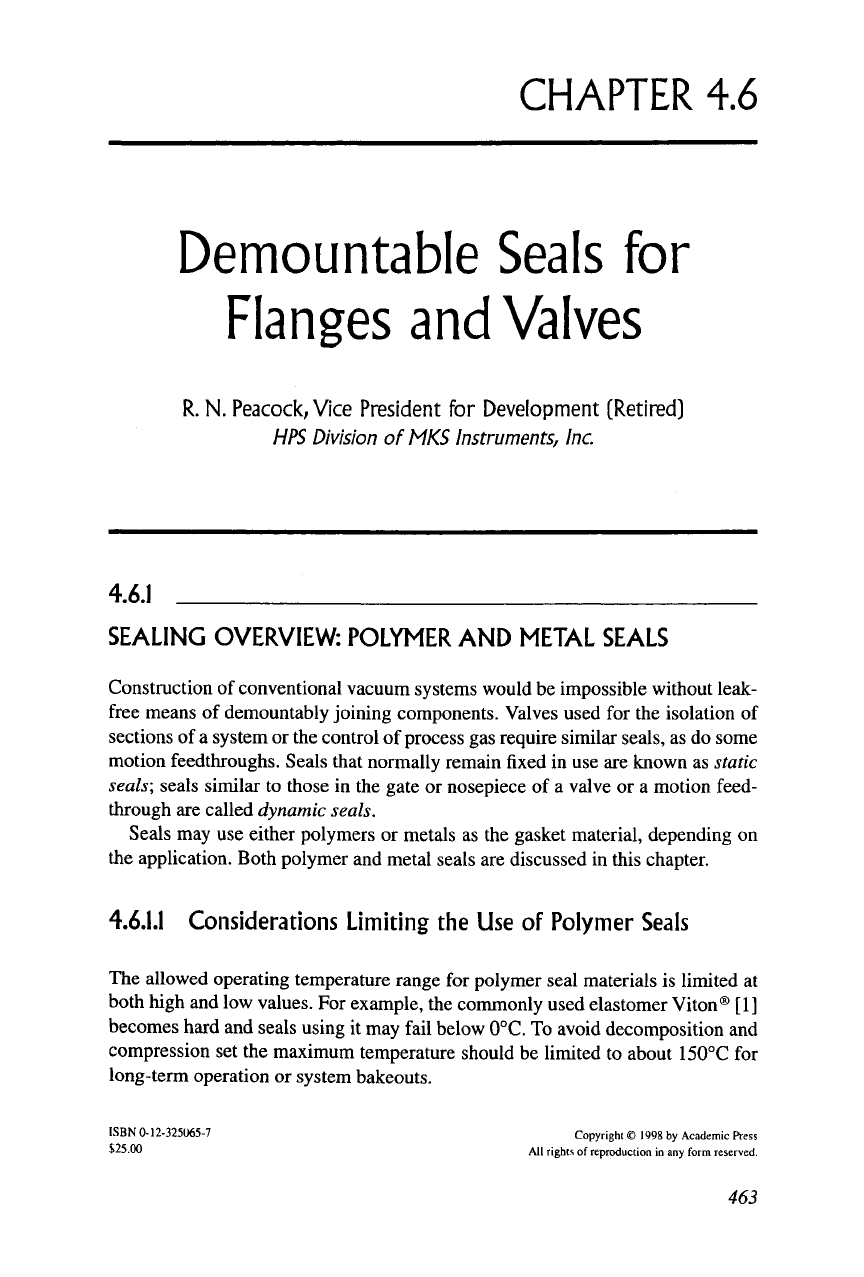
CHAPTER
4.6
Demountable Seals
for
Flanges and Valves
R.
N.
Peacock,
Vice
President for Development [Retired]
HPS Division
ofMKS
Instruments,
Inc.
4.6.1
SEALING OVERVIEW: POLYMER AND METAL SEALS
Construction
of
conventional vacuum systems would be impossible without leak-
free means
of
demountably joining components. Valves used
for
the isolation
of
sections
of
a system or the control
of
process gas require similar seals, as do some
motion feedthroughs. Seals that normally remain fixed
in
use are known
as
static
seals; seals similar
to
those
in the
gate
or
nosepiece
of a
valve
or a
motion feed-
through are called dynamic seals.
Seals may
use
either polymers
or
metals
as the
gasket material, depending
on
the application. Both polymer and metal seals are discussed
in
this chapter.
4.6.1.1 Considerations Limiting the Use of Polymer Seals
The allowed operating temperature range
for
polymer seal materials
is
limited
at
both high and low values. For example, the conmionly used elastomer Viton®
[1]
becomes hard and seals using
it
may fail below 0°C. To avoid decomposition and
compression
set
the maximum temperature should
be
limited
to
about 150°C
for
long-term operation
or
system bakeouts.
ISBN 0-12-325065-7 Copyright
©
1998
by
Academic Press
$25.00
All
rights
of
reproduction
in
any form reserved.
463

464 Chapter 4.6: Demountable Seals for Flanges and Valves
In most well-designed systems using elastomer 0-ring seals, the seals are an
important source of the system gas load, and often determine the ultimate pres-
sure.
A numerical example in Section 4.6.2.2 illustrates this.
In addition, polymers may suffer from chemical attack, aging, and radiation
damage.
4.6.1.2 Applications Requiring Metal Seals
Metal seals are preferable in the following situations:
1.
When the baking or operating temperature is too high or low for polymers
2.
In some chemical environments
3.
When gas from the outgassing of polymers or the permeation of atmospheric
gasses through polymers is not acceptable
4.
When nuclear or ionizing radiation would damage elastomer seals
The cost of building with metal seals is usually much higher than with polymer
seals.
Metal seals require greater forces, so that components must
be
much stronger
and heavier. Greater precision and specific surface finishes are also needed.
4.6.2
THE ELASTOMERIC AND NONELASTOMERIC
POLYMERS USED IN VACUUM SEAUNG
4.6.2.1 General Chemical and Mechanical Properties
of Common Seal Polymers
Table 1 describes some polymers conunonly used in vacuum sealing, along with
some characteristics of each material. Most materials listed are elastomers. Elas-
tomers are rubberlike substances that tend to return to their original shape after
deformation, although the recovery is imperfect. PTFE, PCTFE, and polyimide
are not elastomers, but they are used in many small valves for nosepiece and body
seals.
Unfortunately, naming the material found in a polymer seal is not sufficient de-
scription to fully characterize it. Consider the fluoroelastomer material Viton®.
The term is often used generically for the finished elastomer, not properly as
the trademark of a resin. A seal manufacturer has many proprietary formulas for
O-rings in order to control characteristics such as compression set, hardness, and
sometimes color. To make a generic "viton" 0-ring the manufacturer may buy
Viton® resin from Du Pont Co., or the similar Flourel® [2] resin from 3M Co. A
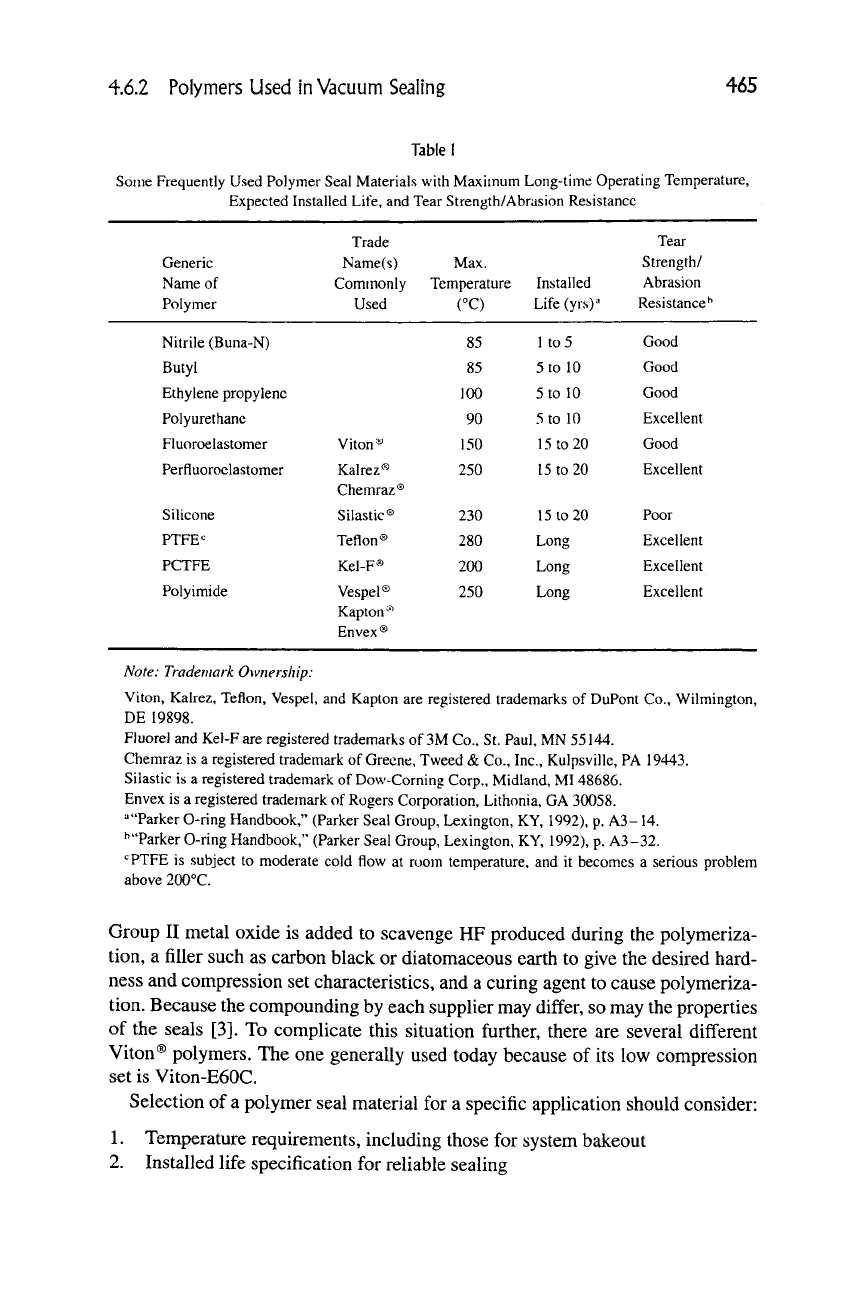
4.6.2 Polymers Used in Vacuum Sealing
465
Table
I
Some Frequently Used Polymer Seal Materials with Maximum Long-time Operating Temperature,
Expected Installed Life, and Tear Strength/Abrasion Resistance
Generic
Name of
Polymer
Nitrile (Buna-N)
Butyl
Ethylene propylene
Polyurethanc
Fluoroelastomer
Perfluoroelastomer
Silicone
PTFE^
PCTFE
Polyimide
Trade
Name(s)
Commonly
Used
Viton^
Kalrez^
Chemraz®
Silastic®
Teflon®
Kel-F®
Vespel®
Kapton®
Envex ®
Max.
Temperature
(°C)
85
85
100
90
150
250
230
280
200
250
Installed
Life (yrs)'-'
1 to
5
5 to 10
5 to 10
5 to 10
15
to 20
15
to 20
15 to
20
Long
Long
Long
Teai-
Strength/
Abrasion
Resistance^
Good
Good
Good
Excellent
Good
Excellent
Poor
Excellent
Excellent
Excellent
Note:
Trademark
Ownership:
Viton, Kalrez, Teflon, Vespel, and Kaplon are registered trademarks of DuPont Co., Wilmington,
DE 19898.
Fluorel and Kel-F are registered trademarks of 3M Co., St. Paul, MN 55144.
Chemraz is a registered trademark of Greene, Tweed & Co., Inc., Kulpsvillc, PA 19443.
Silastic is a registered trademark of Dow-Corning Corp., Midland, MI 48686.
Envex is a registered trademark of Rogers Corporation, Lithonia, GA 30058.
'•"Parker
0-ring
Handbook," (Parker Seal Group, Lexington, KY, 1992), p. A3-14.
^'"Parker
0-ring
Handbook," (Parker Seal Group, Lexington, KY, 1992), p. A3-32.
cpjpg jg subject to moderate cold flow at room temperature, and it becomes a serious problem
above 200°C.
Group II metal oxide is added to scavenge HF produced during the polymeriza-
tion, a filler such as carbon black or diatomaceous earth to give the desired hard-
ness and compression set characteristics, and a curing agent to cause polymeriza-
tion. Because the compounding by each supplier may differ, so may the properties
of the seals [3]. To complicate this situation further, there are several different
Viton® polymers. The one generally used today because of its low compression
set is Viton-E60C.
Selection of a polymer seal material for a specific application should consider:
1.
Temperature requirements, including those for system bakeout
2.
Installed life specification for reliable sealing
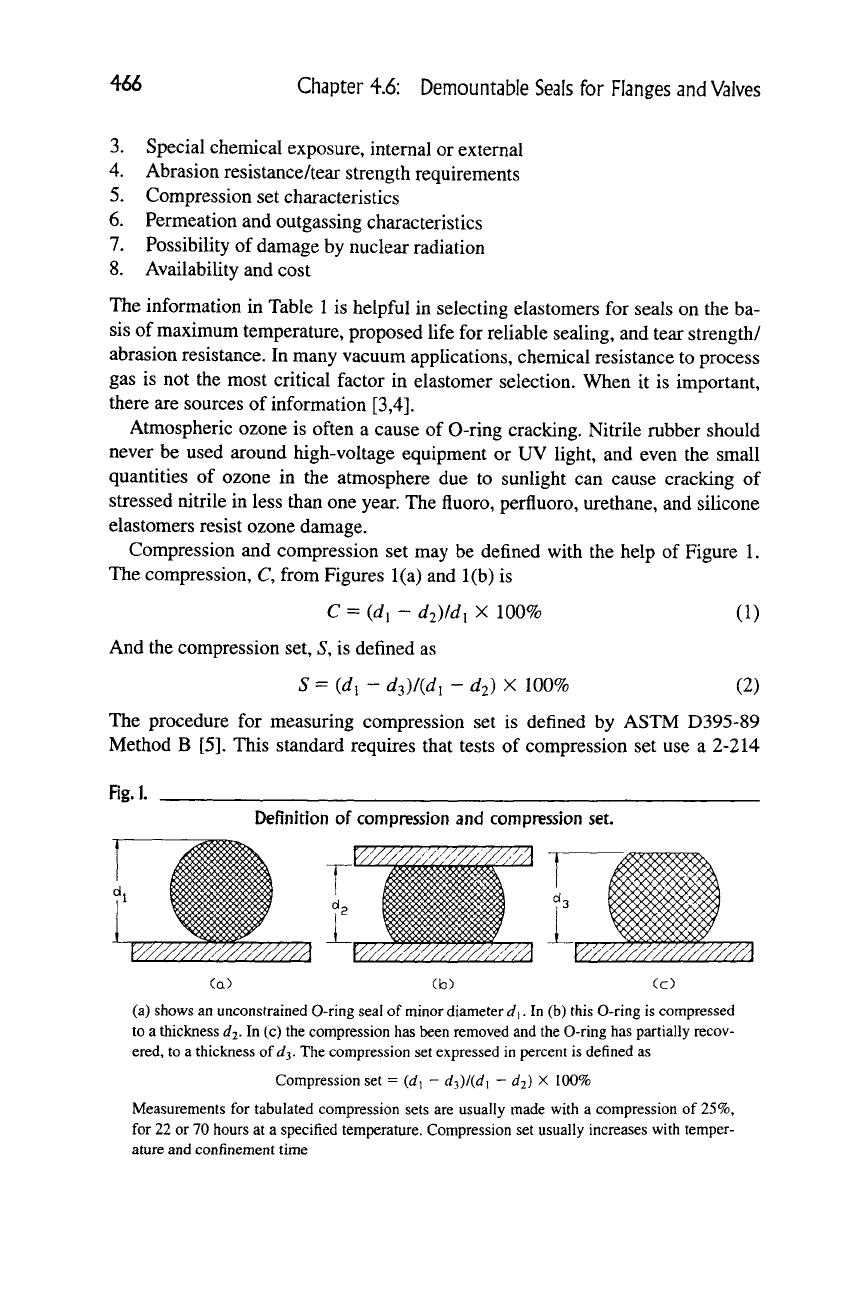
466
Chapter 4.6: Demountable Seals
for
Flanges and Valves
3.
4.
5.
6.
7.
8.
Special chemical exposure, internal or external
Abrasion resistance/tear strength requirements
Compression set characteristics
Permeation and outgassing characteristics
Possibility of damage by nuclear radiation
Availability and cost
The information in Table 1 is helpful in selecting elastomers for seals on the ba-
sis of maximum temperature, proposed life for reliable sealing, and tear strength/
abrasion resistance. In many vacuum applications, chemical resistance to process
gas is not the most critical factor in elastomer selection. When it is important,
there are sources of information
[3,4].
Atmospheric ozone is often a cause of
0-ring
cracking. Nitrile rubber should
never be used around high-voltage equipment or UV light, and even the small
quantities of ozone in the atmosphere due to sunlight can cause cracking of
stressed nitrile in less than one year. The fluoro, perfluoro, urethane, and silicone
elastomers resist ozone damage.
Compression and compression set may be defined with the help of Figure 1.
The compression, C, from Figures 1(a) and 1(b) is
C = (^1 - d2)ldx X 100% (1)
And the compression set, 5, is defined as
5 = (^1 - ^3)7(^1 - d2) X 100% (2)
The procedure for measuring compression set is defined by ASTM D395-89
Method B [5]. This standard requires that tests of compression set use a 2-214
Rg.l.
Definition of compression and compression set.
W>^^^PZ^9>>9m
(a)
(b) (c)
(a) shows an unconstrained
0-ring
seal of minor diameter ^i. In (b) this
0-ring
is compressed
to a thickness
d^.
In (c) the compression has been removed and the
0-ring
has partially recov-
ered, to a thickness of
J3.
The compression set expressed in percent is defined as
Compression set = (flf, - ^3)/(J, - (^2) X 100%
Measurements for tabulated compression sets are usually made with a compression of 25%,
for 22 or 70 hours at a specified temperature. Compression set usually increases with temper-
ature and confinement time
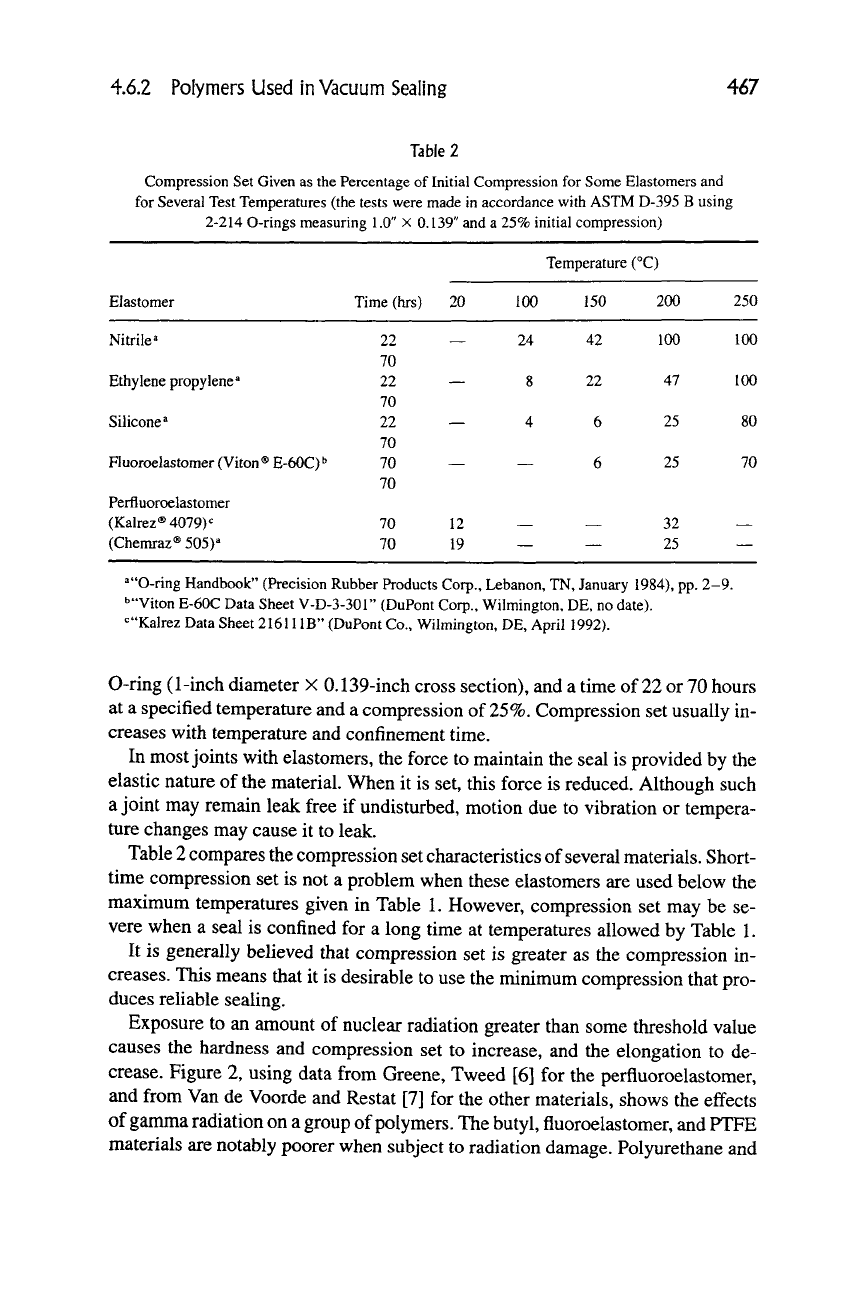
4.6.2 Polymers Used
in
Vacuum Sealing 467
Table
2
Compression Set Given as the Percentage of Initial Compression for Some Elastomers and
for Several Test Temperatures (the tests were made in accordance with ASTM D-395 B using
2-214 O-rings measuring 1.0" X 0.139" and a
25%
initial compression)
Elastomer
Nitrile^
Ethylene propylene*
Silicone*
Fluoroelastomer (Viton®
Perfluoroelastomer
(Kalrez®4079)'=
(Chemraz® 505)*
»E-60C)^
Time (hrs)
22
70
22
70
22
70
70
70
70
70
20
—
—
—
—
12
19
100
24
8
4
—
—
—
Temperature (°C)
150
42
22
6
6
—
—
200
100
47
25
25
32
25
250
100
100
80
70
—
—
*"0-ring Handbook" (Precision Rubber Products Corp., Lebanon, TN, January 1984), pp. 2-9.
'"'Viton E-60C Data Sheet
V-D-3-301"
(DuPont Corp., Wilmington, DE, no date).
'^"Kalrez Data Sheet 21611
IB"
(DuPont Co., Wilmington, DE, April 1992).
O-ring
(1-inch diameter X 0.139-inch cross section), and a time of
22
or 70 hours
at a specified temperature and a compression of
25%.
Compression set usually in-
creases with temperature and confinement time.
In most joints with elastomers, the force to maintain the seal is provided by the
elastic nature of the material. When it is set, this force is reduced. Although such
a joint may remain leak free if undisturbed, motion due to vibration or tempera-
ture changes may cause it to leak.
Table
2
compares the compression set characteristics of several
materials.
Short-
time compression set is not a problem when these elastomers are used below the
maximum temperatures given in Table 1. However, compression set may be se-
vere when a seal is confined for a long time at temperatures allowed by Table 1.
It is generally believed that compression set is greater as the compression in-
creases. This means that it is desirable to use the minimum compression that pro-
duces reliable sealing.
Exposure to an amount of nuclear radiation greater than some threshold value
causes the hardness and compression set to increase, and the elongation to de-
crease. Figure 2, using data from Greene, Tweed [6] for the perfluoroelastomer,
and from Van de Voorde and Restat [7] for the other materials, shows the effects
of gamma radiation on a group of polymers. The butyl, fluoroelastomer, and PTFE
materials are notably poorer when subject to radiation damage. Polyurethane and
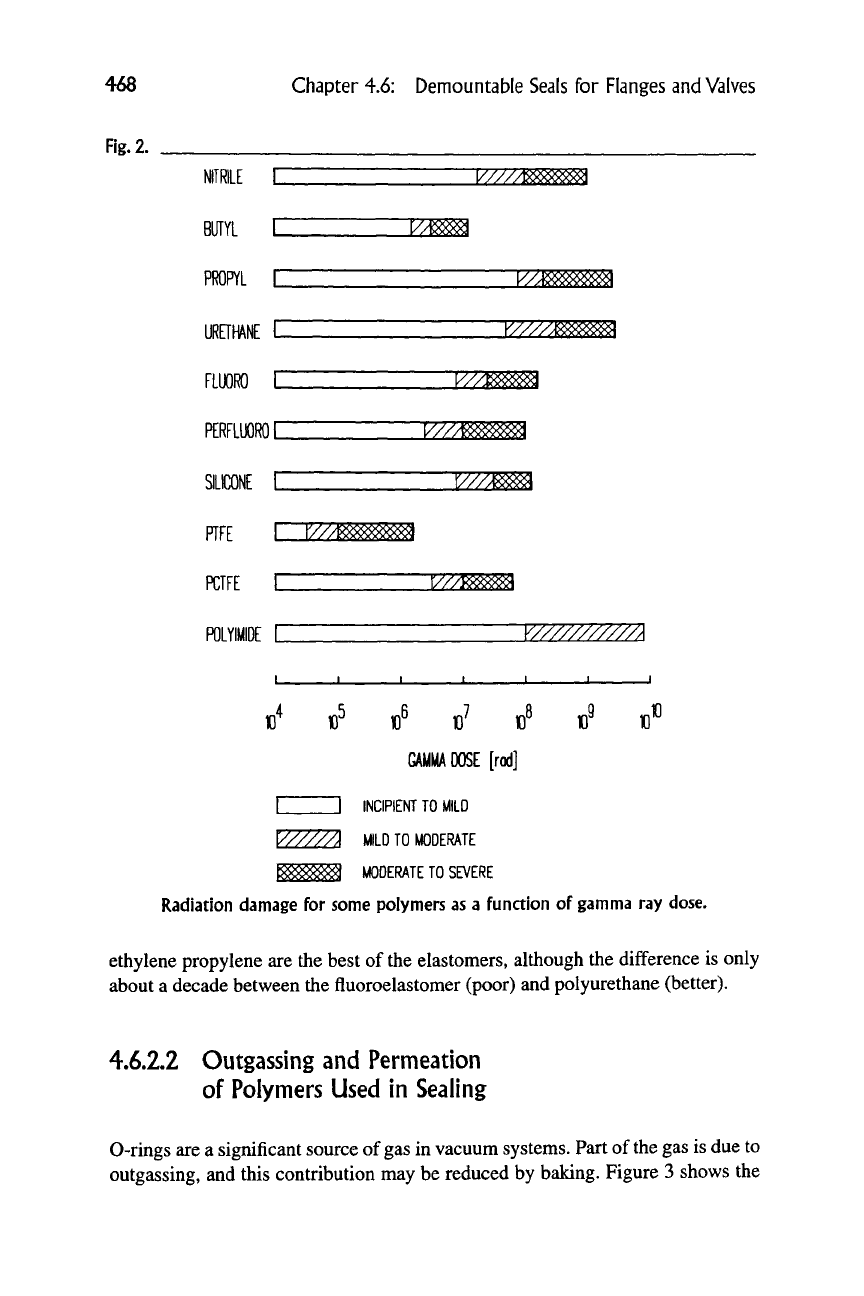
4^
Chapter 4.6: Demountable Seals
for
Flanges and Valves
Rg.2.
NIIRIIF
1
v////m$m$^
RIITYI
1
vmm
FKOPYL
1
v/ms$s$m
IfFTHANE
1
Y////ms$m
FllinRn
1
v//!^m^
PFRFIllORnI
l////«»»«8R1
RllimNF
1
v//jm^
PTFF
1
r///K«88RR$5?3
PTIFF
1
r///K??5?«<
miYIMIIF
1
Y///////////A
I
. 1 1 1 ' ' •
4
5
1
1
V////A
^^^^
^
^ ^ ^ ^B
GAMMA DOSE
[rod]
INCIPIEI^fT TO MILD
MILD TO MODERATE
MODERATE TO SEVERE
Radiation damage
for
some polymers
as
a
function
of
gamma
ray
dose.
ethylene propylene are the best
of
the elastomers, although the difference
is
only
about a decade between the
fluoroelastomer
(poor) and polyurethane (better).
4.6.2.2 Outgassing and Permeation
of Polymers Used
in
Sealing
O-rings are
a
significant source of gas in vacuum
systems.
Part of the gas is due to
outgassing, and this contribution may be reduced by baking. Figure 3 shows
the
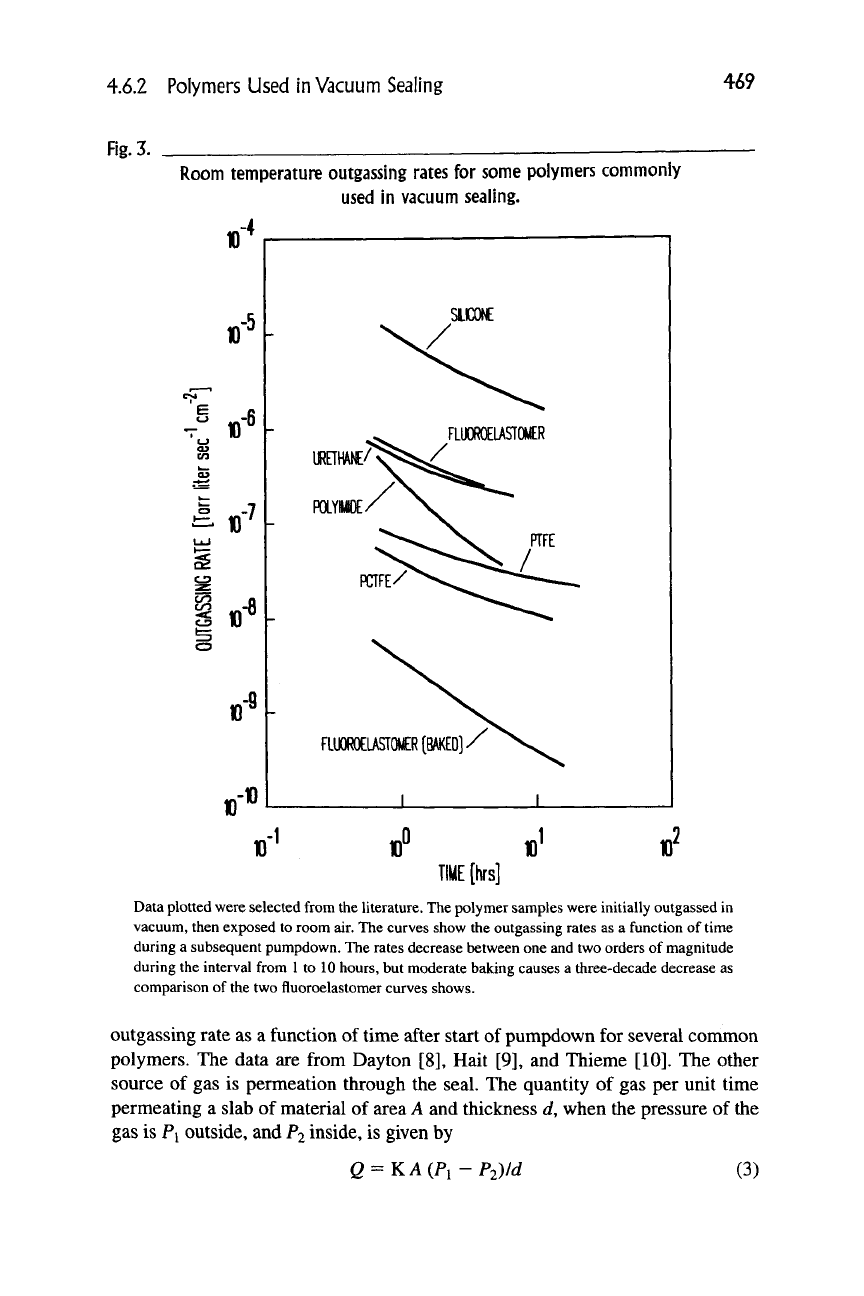
4.6.2 Polymers Used in Vacuum Sealing
469
Fig.
3.
Room temperature outgassing rates for some polymers commonly
used
in
vacuum sealing.
A
10
s
^
10
v
«'
-5
10
cS
10
CD
,-8
n
n
n
n
SUM
auOROELASIOMER
(BAKED]/
r
TIME[hrs]
10'
r
Data plotted were selected from the literature. The polymer samples were initially outgassed in
vacuum, then exposed to room air. The curves show the outgassing rates as a function of time
during a subsequent pumpdown. The rates decrease between one and two orders of magnitude
during the interval from
1
to 10 hours, but moderate baking causes a three-decade decrease as
comparison of the two
fluoroelastomer
curves shows.
outgassing rate as a function of time after start of pumpdown for several common
polymers. The data are from Dayton [8], Halt [9], and Thieme [10]. The other
source of gas is permeation through the seal. The quantity of gas per unit time
permeating a slab of material of area A and thickness d, when the pressure of the
gas is Pi outside, and
P2
inside, is given by
Q = KA{P,-P2)/d
(3)
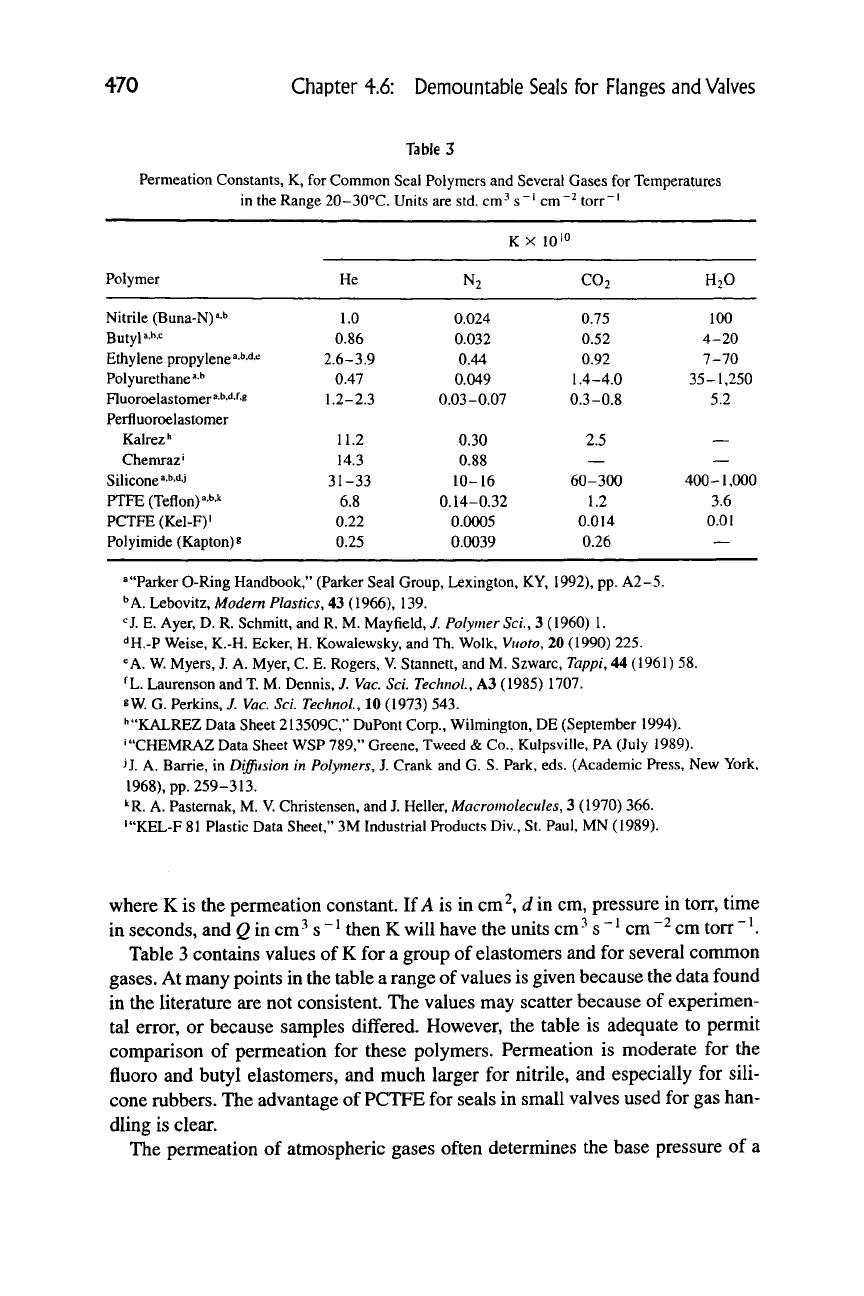
470 Chapter 4.6: Demountable Seals
for
Flanges and Valves
Table 3
Permeation Constants, K, for Common Seal Polymers and Several Gases for Temperatures
' cm"'^ torr"'
Polymer
Nitrile(Buna-N)*»'
Butyl
^'*^'^
Ethylene propylene''•^•^•*^
Polyurethane^-^
Fluoroelastomer ''-^-'^•^'^
Perfluoroelastomer
Kalrez''
Chemraz'
Silicone ^•^•'I'j
PTFE (Teflon)^''''
PCTFE(Kel-F)'
Polyimide (Kapton)^
He
1.0
0.86
2.6-3.9
0.47
1.2-2.3
11.2
14.3
31-33
6.8
0.22
0.25
K X 10
N2
0.024
0.032
0.44
0.049
0.03-0.07
0.30
0.88
10-16
0.14-0.32
0.0005
0.0039
10
CO2
0.75
0.52
0.92
1.4-4.0
0.3-0.8
2.5
—
60-300
1.2
0.014
0.26
H2O
100
4-20
7-70
35-1,250
5.2
—
—
400-1,000
3.6
0.01
—
^"Parker 0-Ring Handbook," (Parker Seal Group, Lexington, KY, 1992), pp. A2-5.
^A.
Lebovitz, Modem Plastics, 43 (1966), 139.
^J. E. Ayer, D. R. Schmitt, and R. M. May
field,
J. Polymer
ScL,
3 (1960) 1.
^H.-P Weise, K.-H. Ecker, H. Kowalewsky, and Th. Wolk,
Vitoto,
20 (1990) 225.
•^A.
W. Myers, J. A. Myer, C. E. Rogers, V. Stannett, and M. Szwarc,
Tappi,
44 (1961) 58.
^L.
Laurenson and
T.
M. Dennis,
J. Vac. ScL
TechnoL,
A3 (1985) 1707.
8W. G. Perkins,
J. Vac.
Sci.
TechnoL,
10 (1973) 543.
''"KALREZ Data Sheet 213509C," DuPont Corp., Wilmington, DE (September 1994).
'"CHEMRAZ Data Sheet WSP 789," Greene, Tweed & Co., Kulpsville, PA (July 1989).
JJ. A. Barrie, in
Diffitsion
in Polymers, J. Crank and G. S. Park, eds. (Academic Press, New York,
1968),
pp. 259-313.
^R.
A. Pasternak, M. V. Christensen, and
J.
Heller, Macromolecules, 3 (1970) 366.
'"KEL-F 81 Plastic Data Sheet," 3M Industrial Products Div., St. Paul, MN (1989).
where K is the permeation constant. If A is in cm^, d in cm, pressure in torr, time
in seconds, and 2 in cm
-^
s
~ ^
then K will have the units cm
^
s
~ ^
cm "
^
cm torr
~ ^.
Table 3 contains values of K for a group of elastomers and for several common
gases.
At many points in the table a range of values is given because the data found
in the literature are not consistent. The values may scatter because of experimen-
tal error, or because samples differed. However, the table is adequate to permit
comparison of permeation for these polymers. Permeation is moderate for the
fluoro and butyl elastomers, and much larger for nitrile, and especially for sili-
cone rubbers. The advantage of PCTFE for seals in small valves used for gas han-
dling is clear.
The permeation of atmospheric gases often determines the base pressure of a

4.6.2 Polymers Used in Vacuum Sealing 471
vacuum system using polymer seals. As an example showing the importance of
permeation consider a stainless steel system of internal surface area 1 m^ having
five fluoroelastomer 0-rings of
8-inch
diameter, and nominal
{-inch
cross sec-
tion. Let the effective pumping speed for the residual gases be 100 liter/s. An or-
der of magnitude calculation will yield an estimate of the pressure 10 hours after
a 150°C bake. The outgassing rate of a fluoroelastomer used as a seal to atmo-
sphere under these assumptions is about 10"^ torr liter s"^ cm~^ according to
de Csematony [11] and Dayton
[8,12].
The outgassing rate of the baked stainless
steel may be taken as
10
~'^ torr liter s "^ cm"^ after Young [13]. The surface area
of the 0-rings is about 3.5 X 10^ cm^, so that the total gas load due to them is
3.5 X 10"^ torr liter s~^ That from the stainless steel is 1 X 10"^ torr liter s~^
The equilibrium pressure is given by P = QIS. The contribution of the seals to the
total pressure is 3.5 X 10"^ torr, while that of the entire chamber surface is only
1 X
10 ~^^
torr. If the system had been built using metal seals the gas load due
to the seals would be negligible, and the ultimate pressure would be about 1 X
10
~'^ torr. It is clear that elastomer seals are often the limiting factor in deter-
mining the ultimate pressure of a vacuum system.
Permeation is important in another specific instance: when a mass spectrome-
ter leak detector is used with helium search gas to check joints with polymer
seals,
permeation can cause false signals. After an 0-ring is exposed to helium
for about a minute, a small signal is seen that rapidly increases. Another order
of magnitude calculation will verify that a helium permeation signal should be
expected. Consider a fluoroelastomer 0-ring of 100 mm diameter and 3.5 mm
(0.139 in) cross section. Assume the effective thickness to be 3.0 mm, and that
J of the area is exposed to helium at atmospheric pressure. From Table 3 the
permeation constant for helium is about 2 X 10"^^ cm-^ s"^ cm~^ cm torr~^
Then the equilibrium permeation rate is 4 X 10"^ std. cm^ s~^ This is a large
leak signal.
Once saturated with helium a polymer seal continues to outgas for a long time,
causing a changing high background that makes further leak testing difficult. For
this reason, it is desirable to design leak detectors without elastomer seals in criti-
cal areas where the mass analyzer would be exposed to evolved gas.
Particulate contamination is a serious problem in integrated circuit fabrication.
0-rings subject to friction in dynamic seals can produce particles. Perhaps these
particles are from the fillers used in compounding. Means of reducing particulates
from seals are discussed by De Laurentis, Wu, Salfelder, and Uritsky [14].
4.6.2,3 Review of O-Ring Material Selection
0-rings made of nitrile rubber are limited to applications in unbaked vacuum sys-
tems because the maximum allowed temperature is 85°C. It is prone to cracking
